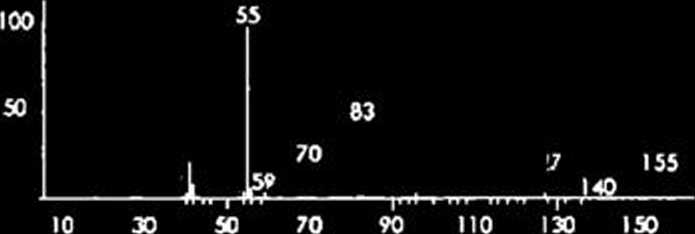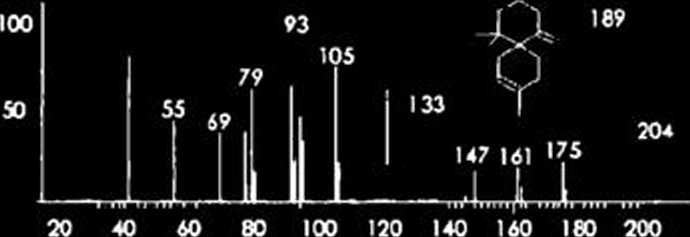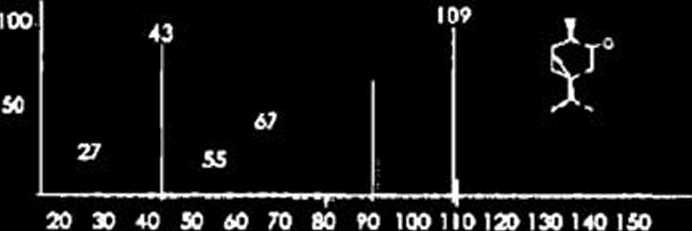117828195
Journal of Chromatugraphic Sci«?nce, Vol. 47, August 2009
Table II. Seven Volalile Compounds Most Frequent)y Appearing in the Salvia Species With Their Respective StructuraJ Formulas and Mass Spectra
Yolatile Compound StructuraJ Formulas and Mass Spectra
100
93
a-Pinene
50
27

fam nti
105 '21
*1c
Itr innn
9|««t r
136
i
triloba contains no /3-pinene, and camphene, and S. officmalis is deprived of /^-chamigrene, thujol, and cadina-3,9-diene.
There are still other yolatile components, which remain unidentified in our experiment, yet they frequentJy appear in many investigated sagę species. For the sake of an example, compo-nent with the retention time equal to 26.01 min is present in fourteen Sałoia species, and its rela-tively highest levels are observed with S. azurea, S. pratensis, S. staminea, S. cadmica, and S. sclarea.
Camphene
20 30 40
77
53 67 ll
50 60 70 00
90 100 110 120 130

p-Pinene
27
77
107
nfrt-T-i
•21 136
p Chamigrene
10 20 30 40 50 40 70 00 90 100 110 120 IX

Conclusions
In our HS-CC-MS study, we obtained finger-print gas chromatograms of the yolatile fraction from 20 Safoia species most frequently grown in Poland. Seven yolatile compounds were identi-fied as characteristic of the prevailing mąjority of the investigated species. With four species, unique yolatile compounds were found, enabling them to act as their respective chemotaxonomic markers. With 13 species, certain yolatile compounds were identified, which (although not unique for these species) can be considered as their respective chemotaxonomic advice. With five species, an absence of the otherwise fre-quently occurring yolatile compounds was observed, which can be considered as a respec-tive chemotaxonomic advice, as well.
100
95
Camphor
55 69
108
152
77
ll.....lift
ThujoJ
|l Mai!\{ i| mI|I • H.|lll Ii «|Nlłl
2C 30 40 50 60
h.
70
l*»* | in^ii minji ii
80 90 100 MO 120 IX 140 150

Cadina 3,9-dicne
|
_ | |||||
|
'T' T'-' | |||||
20 40 60 80 100 120 140 160 180 200
1. M. Roberts. Margaret Roberts' Book ot Herbs: The Medicinal and Culinary Uses of Herbs in South Africa. Southern Book Publishers, National Book Printers, Goodwood, Cape, 1986.
2. R.D. Cantino, R.M. Hariey, and S.J. Wagslaff. Genera of Labiatae: status and classification. In: Advances In Labiatae Science. Fds, R.M Hariey and I. Reynolds. Royal Botanical Gardens, Kew, UK, 1992, pp, 511-522.
3. L.t.W. Codd. I.amiaceae. In: Flora of Southern Africa 28,4. Botanical Research Institute, Pretoria, 1985.
4.1.C Hedge. A global survey of the biogeog raphy of the Labiatae. In: Advances in Labiatae Science, tds, R.M Hariey and T. Reynolds. Royal Botanical Gardens, Kew, UK, 1992, pp. 7-17.
5. B.M. Lawrence. Chemical components of Labiatae oils and their exploitation. In. Advances in Labiatae Science. Fds, R.M Hariey and I. Reynolds. Royal Botanical Gardens, Kew, UK, 1992, pp. 399-436.
6. S.J. Wagstaff. A phylogenetic interpretation of
Wyszukiwarka
Podobne podstrony:
Journal of Chromatograpłiic Science, Vol. 47, August 2009 pollen morphology in iribe MerAheae (Labia
Journal of r.hromatographii- Science, Vol. 47, August 2009 qualitative and quantitative determinatio
Journal of ChromałographK. Scence, Vol. 47, August 2009Fingerprint of Selected Salvia Species by HS-
diagnostyka laboratoryjna Journal of Laboratory Diagnostics 2011 • Volume 47 • Number 2 • 197-203 Pr
Zarządzanie i Finanse Journal of Management and Finance Vol. K3, No. 3/2/2015 Wojciech
diagnostyka laboratoryjna Journal of Laboratory Diagnostics 2011 • Volume 47 • Number 3 •
IJCSI International Journal of Computer Science Issues, Vol. 7, Issue 3, No 9, May 2010
12 IJCSI International Journal of Computer Science Issues, Vol. 7, Issue 3, No 9, May 2010 www.IJCSI
IJCSI International Journal of Computer Science Issues, Vol. 7, Issue 3, No 9, May 2010
14 IJCSI International Journal of Computer Science Issues, Vol. 7, Issue 3, No 9, May 2010 www.IJCSI
15 IJCSI International Journal of Computer Science Issues, Vol. 7, Issue 3, No 9, May 2010 www.IJCSI
Cross-Cultural Validation, Journal of Computer-Mediated Communication, vol. 5, no.
diagnostyka laboratoryjna Journal of Laboratory Diagnostics 2011 • Volume 47 • Number 1 • 91-97 Prac
diagnostyka laboratoryjna Journal of Laboratory Diagnostics 2011 • Volume 47 • Number 3 • 331-334 Pr
diagnostyka laboratoryjna Journal of Laboratory Diagnostics 2011 • Volume 47 • Number 2 • 455-460 Pr
więcej podobnych podstron